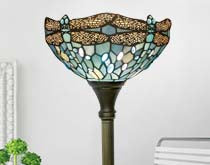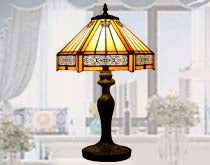What Are Tiffany Lamp Made Of?
Tiffany lamps are primarily made from colorful stained glass that is carefully selected and assembled to create spectacular mosaic-like designs.
The charm of Tiffany lamps lies not only in their bright colors and patterns, but also in their unique production techniques. This article will take you through how Tiffany lamps are made.
What Are Tiffany Lamps?

A Tiffany lamp is a decorative lamp characterized by a colorful stained glass shade, often inspired by the intricate patterns of nature. Made from sheets of glass cut into specific shapes and then edged with copper foil, Tiffany lamps are highly valued both as collectibles and for their aesthetic appeal.
What Are Tiffany Lamps Made Of?
-
Multicolored Glass
-
copper foil
-
solder
-
metal base
-
lead bar
The creation of a Tiffany table lamp is a meticulous process that blends artistry with precise craftsmanship, starting with an initial watercolor sketch and ending with a beautifully finished product. Here's a comprehensive overview of the entire process:
1. Design and Preparation
The process begins with a conceptual watercolor sketch of the lamp design. Once that sketch is approved (usually from the lead designer or art director), it moves on to the next stage. Wooden models are made based on the approved design.
The model serves as a three-dimensional template for the lampshade and is engraved with a detailed design to guide subsequent steps.
2. Glass Selection and Cutting
Glass Selection: The glass selector chooses from numerous glass pieces, each with a different color, tint, and opacity. These colors determine the visual impact and uniqueness of each lamp.
Cutting: The glass cutter then traces the design onto the glass using a tool equipped with a diamond or metal wheel. The glass is scored along the lines of the design and then broken to match the pattern exactly. Use tools like pliers or rough-nose pliers to perfect the shape.
3. Assembly
Copper foil wrapping: The edge of each cut glass is wrapped with a thin strip of copper foil, with the front and back slightly overlapping. This step prepares the parts for assembly by welding.
Forming the Lampshade: Assembly begins by placing a brass ring on top of the mold to serve as the frame for the lampshade. Place each wrapped piece of glass on the mold, apply flux, and use a hot soldering iron to solder the pieces together.
4. Complete Lampshade
Reinforcement and Stability: Once assembled, remove the lampshade from the mold, flip it over, and apply additional solder along the inner copper foil to strengthen the structure. A brass ring is welded to the bottom edge of the shade for added stability.
The final step is to apply a patina solution to the solder wires to achieve the desired color effect, usually bronze or gold, which enhances aesthetics and protects the solder from oxidation.
The complex production process of the Tiffany lamp not only highlights the artistic component of the Tiffany lamp, but also demonstrates the detailed craftsmanship required to assemble and complete both decorative and functional pieces.
How to Identify a Tiffany Lamp

Tiffany lamps are of great historical significance and collectible value, so users who purchase Tiffany lamps also want to have the knowledge to identify authentic Tiffany lamps. In order to confirm whether you are buying genuine products, you can identify them in the following ways:
1. Check the Manufacturer’s Markings
Authentic Tiffany lamps are often marked Tiffany Studios, New York or simply TGS. These markings can usually be found on the lamp base. If the mark contains the word Co. this is a sign that it may not be authentic as the original Tiffany lamp did not use this in the mark.
2. Check Glass Quality
Tiffany lamps are known for their high-quality glass, which comes in vibrant colors and a variety of textures and opacities. Look for glass that displays different hues and depths of color when lit and unlit. The surface of the glass should also be somewhat uneven, indicating a hand-rolling process.
3. Inspection Process
The craftsmanship of authentic Tiffany lamps is very detailed. The leads (the metal wires that connect the glass pieces) should be very fine and highly precise. Each piece of glass should fit perfectly within its leaded frame with no gaps or unevenness.
4. Looking for Patina
The metalwork on an original Tiffany lamp, especially the base, should have a natural patina that develops over time. This patina should not look artificially applied or even. It usually has a green or brown hue.
5. Consider Design and Patterns
Authentic Tiffany lamps often feature nature-inspired designs such as dragonflies, peacocks, flowers and intricate geometric patterns. Familiarize yourself with common Tiffany lamp designs and compare them to related lamps.
6. Consult an Expert
Because of the high value and numerous reproductions of Tiffany lamps, the best way to ensure the authenticity of a Tiffany lamp is to consult with an expert or certified appraiser who specializes in Tiffany and other art glass.
Identifying a genuine Tiffany lamp requires careful examination of its materials, workmanship and provenance. If you are unsure, professional verification is always recommended to protect your investment.
How to Maintain Tiffany lamps?
Maintaining a Tiffany lamp such as a Tiffany floor lamp or a Tiffany chandelier involves cleaning, care, and proper storage methods to maintain its artistic beauty and integrity. Here are some key maintenance steps:
1. Clean
Dust regularly: Use a soft, dry cloth or feather duster to gently remove dust from the lampshade and base. Avoid using abrasive cleaners or sprays, which may damage the glass or metal finish.
Cleaning the glass: You can use mild soapy water and a soft cloth to clean. Be sure to rinse with clean water and dry immediately after use to prevent water stains. Lampshades should never be soaked to avoid damaging the glass and solder joints.
Polishing Metal Parts: If a metal part needs cleaning, choose a cleaner or polish suitable for the type of metal (usually bronze). Be careful not to scratch any naturally occurring patina when using it.
2. Use and Storage
Handle with Care: Always handle Tiffany lamps by the base, not the shade, to avoid stress on the solder joints. Tiffany lampshades are fragile and can be heavy and need to be handled with care.
Use the right light bulbs: Avoid high-wattage light bulbs as they generate more heat and can cause damage to the glass. LED or low-wattage light bulbs are recommended because they generate less heat and are energy efficient.
Proper Storage: When storing for an extended period of time, the lamp should be placed in a dry, cool environment. The lampshade and base should be wrapped in soft breathable materials respectively to prevent dust and scratches. Avoid using plastic packaging as it can trap moisture, causing damage.
3. Periodic Inspection
Check light fixtures regularly for loose parts or cracked glass. If damage is discovered, a professional antique lighting restoration expert or glass workmanship conservation expert should be consulted for appropriate restoration.
Summarize
At its core, a Tiffany lamp is more than just a lamp; it is a monumental work of art. Made from richly colored stained glass and wrapped in copper foil, these lamps showcase Louis Comfort Tiffany's mastery of glass and light.
Featuring intricate designs, often inspired by nature, each lamp embodies a unique blend of beauty and craftsmanship. I believe that by understanding this product information, you can choose a high-quality Tiffany lamp for your space.

























